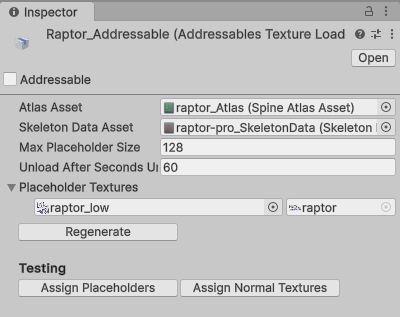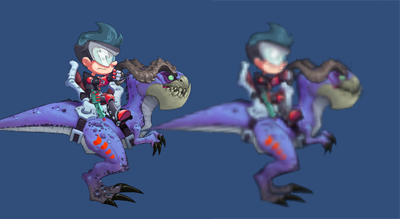Licensing
A Spine license is required to integrate the Spine Runtimes into your applications.
On-Demand Loading UPM Packages
Why On-Demand Loading
Your project may require many skins and atlas page textures per skeleton where only a fraction needs to be loaded up front. Note that all atlas textures are indirectly referenced by the SkeletonDataAsset, and are therefore loaded when the skeleton is loaded. This follows standard Unity loading behavior.
To optimize memory usage and application download size, textures can be loaded dynamically at runtime using the on-demand loading UPM packages below. They allow integration with systems like Unity Addressables to download high-resolution atlas textures only when a corresponding skin is assigned. This reduces initial load size at the cost of small runtime loading delays.
UPM Packages
On-Demand Loading in spine-unity is supported through separate Unity Package Manager (UPM) extension packages. Two UPM packages are currently available:
- Addressables UPM Package
com.esotericsoftware.spine.addressables
A ready-to-use implementation based on Unity Addressables. - On-Demand Loading UPM Package
com.esotericsoftware.spine.on-demand-loading
A generic infrastructure package for implementing on-demand loading.
Addressables UPM Package
The Spine Addressables plugin adds support for on-demand texture loading to the spine-unity runtime through integration with the Unity Addressables system.
This module covers all necessary steps to automatically replace your textures with low-resolution placeholder versions and loads high-resolution textures on demand. A pre-build step replaces the textures in the build output with their low-resolution counterparts, while a post-build step restores the original high-resolution textures in your project. No additional coding is required.
Installation
The Spine Addressables Extensions package com.esotericsoftware.spine.addressables depends on the Spine On-Demand Loading Extension package com.esotericsoftware.spine.on-demand-loading. Please install the On-Demand Loading package before installing the Addressables package.
See section Optional Extension UPM Packages on how to download and install UPM packages and section Updating an Extension UPM Package on how to update them.
Usage
The following steps are all that is required to configure your textures to be replaced with low-resolution placeholders and high-resolution versions loaded automatically on demand.
- Declare your original high-resolution target Material textures as addressable.

- Select the
SpineAtlasAsset, right-click theSpineAtlasAssetInspector heading and selectAdd Addressables Loader.

- This generates an
AddressableTextureLoaderasset.

- This asset provides configuration parameters and sets up low-resolution placeholder textures which are automatically assigned in a pre-build step when building your game executable.

- Build your Addressables content as usual.
From now on when building your game executable, the low resolution placeholder textures are automatically assigned initially and the corresponding high-resolution textures loaded on-demand.
Editor Preview
Please note that the low-resolution textures are only activated during the game build process. They are not visible in the Unity Editor, including during play mode.
If you'd like to preview the behavior with low-resolution placeholders in the Editor, you can temporarily assign them for testing. To do this, select the desired AddressableTextureLoader asset and hit Testing - Assign Placeholders to temporarily replace the high-resolution textures with their low-resolution placeholders.

You can then observe the high-resolution textures being loaded on-demand during play-mode. Note that this change is for preview purposes only and has no effect on the built game executable. There is no need to manually assign placeholder textures for builds - the system handles this automatically through a pre-build step, with the original textures restored in a post-build step.
On-Demand Loading UPM Package
The core infrastructure for on-demand loading of atlas textures is provided by the separate
Spine On-Demand Loading Extension package com.esotericsoftware.spine.on-demand-loading. The Spine Addressables plugin (com.esotericsoftware.spine.addressables) builds upon this foundation and provides a concrete implementation based on the Unity Addressables system.
See section Optional Extension UPM Packages on how to download and install this package and section Updating an Extension UPM Package on how to update it.
You can create custom loading implementations by deriving from GenericOnDemandTextureLoader and implementing any abstract methods. The AddressablesTextureLoader class can be used as a reference. If GenericOnDemandTextureLoader is not a good fit, you can go one step further and derive your own class from OnDemandTextureLoader and provide a fully custom implementation. This allows for alternative loading strategies tailored to specific project requirements.
